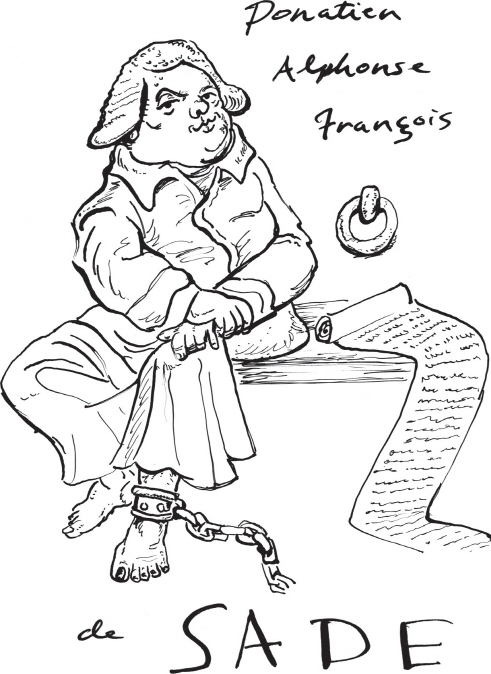Anonyponymous (9 page)
Authors: John Bemelmans Marciano

Taking inspiration from Ovid’s tale, George Bernard Shaw’s
Pygmalion
features the phoneticist Henry Higgins, who makes a bet that he can transform the speech of Cockney flower girl Eliza Doolittle to the point where he can pass her off as a duchess. In the third act, Eliza utters the line, “Walk! Not bloody likely.” At the time,
bloody
was not a quaint Britishism but something more akin to
fuck
, replaced with euphemisms like
blasted
,
blooming
, and
blinking
. When the word was used onstage, it caused a sensation. (Shaw even wrote in his stage direction, “[Sensation].”)
Pygmalion
became a synonym for curse word, and people began to say “not pygmalion likely” and “pygmalion hell!” Though this use had faded from the language, pygmalion, in the sense of a person who attempts to mold the behavior of another, endures.

quis·ling
n. The native puppet of an occupying power.
Vidkun Quisling was the son of a pastor and Norway’s premier fascist. He formed the Nasjonal Samling Party in 1933 with the aim of becoming Norway’s first Fører. What he was selling, however, Norwegians weren’t buying; few joined his lonely party, and a measly 2 percent was his best showing at the polls. Frustrated by his countrymen, Quisling met Hitler to ask him if he would please invade his homeland, a request his hero promptly granted. When fascist troops arrived on Norwegian soil in April 1940, Vidkun seized the day and announced a coup over the radio.
Hitler didn’t return his devotee’s ardor, considering Quisling a loser, and removed him from power at once; however, a Reichskommisar proved little more popular than a Quisling, and Vidkun was named premier of the puppet government in 1942, a post he lasted in until his arrest in 1945. He was the same year executed, a feat not easily accomplished in any Scandinavian country, particularly one lacking the death penalty.
The adoption of the word
quisling
spread fast into languages across the continent and beyond, putting Vidkun in the rarified company of Judas Iscariot and Benedict Arnold as men so vilified that their very name means traitor. Vidkun, however, is the only one obscure enough to have had his name decapitalized.
rit·zy
adj. High-class; fancy.
César Ritz was just another country bumpkin who came to the big city to work as a waiter, but unlike the rest of us he put his heart into it. Already by age nineteen “César le rapide” had risen to be maître d’hôtel at the posh Chez Voisin in Paris, where his legend as tastemaker to the wealthy began. It grew exponentially as he managed hotels across belle epoque Europe, most fortuitously Monaco’s Grand Hotel, where Ritz met chef Auguste Escoffier. Escoffier had worked his way up through the finest kitchens in France, including a brief stint as the chef de cuisine of the French army during the Franco-Prussian war. (It might’ve gone better had the troops been hungrier, as the conflict was, even by the lowest of French standards, an epic catastrophe.)
Ritz and Escoffier became a team, and their decade of success at London’s Savoy Hotel emboldened César to lease a palace on the Place Vendôme, the most fashionable square in Paris, and open the Hotel Ritz in 1898. Its success was instantaneous and sensational, and
Ritz
itself became the international byword for luxury. “Putting on the Ritz” meant to dress up swell, and the verb
to ritz
meant to put on airs. It could also have meant to reach the pinnacle of your profession and then suffer a complete mental breakdown, which is what happened to poor César, who would spend the last two decades of his life in convalescence while Escoffier cemented his reputation as the greatest French chef in history.
ORIGINAL RECIPES
In 1892–1893, one of the guests at the London Savoy was the great soprano Nellie Melba; during this time Escoffier is credited with naming not one but
two
famous dishes after her. Melba toast hardly needed Escoffier’s genius to be invented; when Nellie had a spell under the weather it was the one thing she could eat, but with Escoffier’s imprimatur even this blandest of items took on the sheen of high elegance. Rather more rich is the dessert he created in the diva’s honor, peach melba.
Examples of epicurean homages abound, from General Tso’s chicken to beef carpaccio, named after a nineteenth-century military man from Hunan province and a Renaissance-era painter from Venice, respectively. Rarer is the case of the honoree actually having something to do with the dish named after him or her, but they do exist.
A year or so after Melba’s stay at the Savoy, a young stockbroker on the opposite side the pond walked into another storied hotel, the Waldorf, nursing a wicked hangover. To make himself feel better, Lemuel Benedict, like Dame Nellie, ordered toast, except Benedict asked for it to be loaded with bacon and a poached egg, plus some hollandaise sauce on the side, please. Knowing a good thing when he saw one, the Waldorf ’s young maître d’hôtel, Oscar Tschirky, substituted ham and an English muffin for bacon and toast and put eggs Benedict on the hotel menu. Oscar of the Waldorf (as he would become known) stayed on the job fifty years and, though not a chef, created veal Oscar and the Waldorf salad, made Thousand Island dressing an American staple, and wrote a bestselling cookbook.
Thirty years later, over on the West Coast, Prohibition would prove a boom time for Mexico, as Americans who wanted to liquor up legally had to travel south of the border to party. Cesare Cardini, an Italian restaurateur in San Diego, saw the opportunity and opened a restaurant in Tijuana, where in 1924 he created a salad of romaine lettuce, croutons, and Parmesan cheese with an olive-oil-and-egg-based dressing (but no anchovies). Caesar’s salad became a favorite among the movie-star set, who brought it back home with them.
Another imported dish with a Hollywood imprimatur dates to the 1920 marriage of Douglas Fairbanks to Mary Pickford, the original Brangelina. For their honeymoon, the bride and groom visited Rome, where they stopped one night at the restaurant of Alfredo di Lelio. They fell in love with his signature fettuccine dish and, like many an American before and since, came home from Italy raving about the food they ate. But unlike for the rest of us, other people cared. (You can still get a fettuccine Alfredo at di Lelio’s restaurant; the authentic version is made with heaps of butter and Parmesan cheese.)
The latter half of the roaring twenties saw two Brown Derby eateries open in Los Angeles. The original was a diner constructed in the shape of a hat, but the second, more upscale version became headquarters for the great stars of the day. One of its owners, Bob Cobb, raided the Derby’s fridge late one night, chopping up what he could find into a salad. Whether the snack he made was for himself or for Clark Gable, as varying legends have it, the Cobb salad would become Hollywood’s homegrown dish of fame.
sa·dism
n. The urge to derive pleasure from the abuse and
humiliation of another; cruelty.
Donatien Alphonse François, the Marquis de Sade, was born in 1740 to one of the oldest families of French nobility. At a young age he began a military career that would last until the end of the Seven Years’ War, at which point he married a loving woman who would bear him three children.
In 1768, de Sade decided to celebrate Easter Sunday by bringing home a beggar woman to imprison, sexually assault, and torture. Though the incident landed him in jail, the marquis saw no reason to repent. In 1772, he had an orgy with a male servant, a couple of prostitutes, and a pillbox of Spanish fly. It was all going swimmingly until the girls became convinced that the aphrodisiac was making them sick, and de Sade found himself sentenced to death for sodomy and poisoning. Though he escaped execution, the rest of the marquis’s life was a merry-go-round of incarceration and freedom. Prison, however, provided de Sade time to write. His most depraved work,
The 120
Days of Sodom
, was composed on a forty-foot roll of paper inside the Bastille. In it, he chronicles the doings of a group of wealthy middle-aged men who spend the allotted 120 days in a castle abusing and killing a gaggle of victims, which includes various pubescent girls and boys, four old ladies, their own wives and daughters, and eight men chosen solely for the enormous size of their penises. It’s worse than it sounds. A
lot
worse.

The French Revolution proved to be de Sade’s lucky day; the new men in charge were far more accepting of his sexual escapades than the previous administration. In fact, not only did the marquis get released, but as Citizen Louis de Sade, he took an active role in local politics. Even for de Sade, though, the Reign of Terror was a bit over the top; he found himself again in jail, this time convicted, amazingly, of the crime of “moderatism.” With the overthrow of Robespierre, de Sade was spared the guillotine and released, only to be tossed back into jail by Napoleon for his pornographic writings. Declared insane, de Sade was transferred to an asylum, where he began a paid affair with a chambermaid in her early teens that continued until he died in his sleep, peacefully.
The Marquis de Sade, by the way, was really fat.
shrap·nel
n. Fragments from an explosion.
Henry Shrapnel was a lieutenant in the British Royal Artillery when, on his own initiative and dime, he developed an exploding cannonball. Originally dubbed “spherical case shot,” the weapon came to be called the Shrapnel shell after its 1803 adoption by the British army. Jacques Chauvin and French soldiers everywhere just called it bad news, and in 1814 Shrapnel was awarded a lifetime twelve-hundred-pound-a-year pension for his contribution to the empire.
side·burns
n. The hair that grows on the side of the face
in front of the ears.
General Ambrose Burnside had about as bad a war as any general on the winning side can have. In the early days of the Civil War Burnside presided over the left wing of the Army of the Potomac at Antietam, where he failed to distinguish himself. Nevertheless, when Lincoln fired the overcautious General McClellan from overall command of the Union army, he promoted Burnside, who himself doubted he was up to the job. Burnside promptly led the North to its humiliating defeat at Fredericksburg and the even more humiliating “Mud March.” Excoriated by his inferior officers, Burnside wanted them punished for insubordination and offered to resign if he was wrong. To Burnside’s surprise, Lincoln accepted his resignation and awarded the job to the most vicious of his critics, General Joseph Hooker.
Burnside’s Civil War career was not over, however, as he played a key role in what would become known as the Battle of the Crater. In an attempt to break the stalemate at the Siege of Petersburg, Union leadership devised a Secret Plan. The first part of the operation went wondrously well—coal miners dug a shaft under Confederate lines and detonated an enormous cache of dynamite, killing scores of Johnny Reb. But as Burnside’s men were pursuing the flee-ing Southern troops, the plan went awry. A division of black troops tapped to lead the charge around the edge of the crater was pulled back, for fear of political repercussions if too many were killed (or so Grant later claimed). Unfamiliar with the plan, the replacement white soldiers decided, Wile E. Coyote–like, to take the most direct route across the battlefield: right
into
the crater. The Confederates reformed, circled the rim, and shot down Union troops like fish in a barrel. Burnside was finally, mercifully discharged, never to be recalled again.
